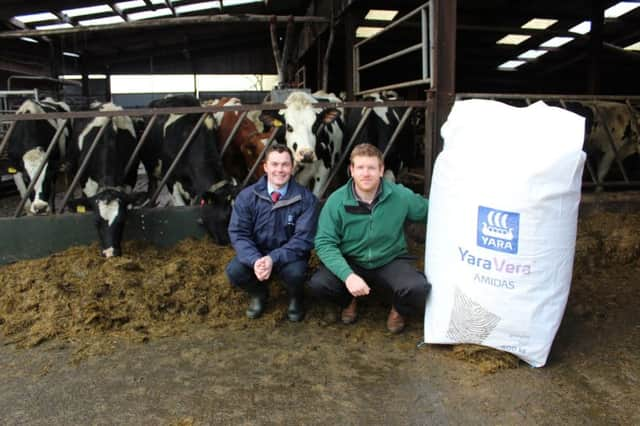Added sulphur makes a real difference to silage quality on Coleraine dairy farm


David Campbell milks 75 pedigree Holstein cows with his father William and mother Lillian. Their Ballylagan herd, one of the oldest dairy pedigree names to be registered in Northern Ireland, has been milked robotically since 2013. The cows are currently averaging 10,180L at 4.01% butterfat and 3.28% protein.
“These are 305 day figures,” said David.
“The robotic approach has worked tremendously well for us. We have specifically included the Grazeway option, which provides cows with direct access to the grazing paddocks for lengthy periods of the year. We preferred this management tack, as opposed to that of the zero grazing alternative.
Advertisement
Advertisement
“The cows are currently averaging 2862L of milk from forage alone.”
Simplicity is another hallmark of the Campbells’ approach to milk production.
“We don’t have a diet feeder,” said David.
“During the winter months the cows are offered grass silage with high quality dairy nuts fed to yield. As the herd performance would indicate, high levels of concentrate are offered, particularly to those cows in early lactation. And, in order to make that achievable, we have included an out-of-parlour feeder in tandem with the robot.”
Making high quality silage is another priority for the Campbells.
“We take three cuts annually,” David confirmed.
Advertisement
Advertisement
“I am a member of my local dairy business development group. Back in early 2016, the issue of Northern Ireland being a sulphur-deficient region came up at one of the meetings. On the back of this I determined to specifically include the element in the future fertiliser specification drawn up for the farm.”
The first opportunity David actually had to put this principle into practise presented itself when he got round to making 2016’s second cut silage crop. After discussing the matter with the management team at Yara, he opted to spread the company’s AMIDAS offering. The product is a sulphur-enriched granular urea source.
“As soon as we started feeding the silage in question, I had it analysed,” said David.
“To say that I was pleasantly shocked with the results that came back would be an understatement. Forage protein levels were up at 17%. Normally, that figure would have come-in at between 11% and 12%.
Advertisement
Advertisement
“Having forage of this quality helps to maintain milk quality while also giving farmers the option of reducing the protein levels in the concentrates they are feeding.”
“This allows David to reduce feed costs by reducing the protein in concentrate but allows him to feed more energy into the cows’ diet. This helps maintain great milk yields while helping keep the energy status of the cow right so that she doesn’t lose any body condition and gets back into calf quicker and easier.”
On the back of the 2016 results, David committed to spreading AMIDAS on his 2017 first cut silage ground.
“I was told that added sulphur will have its optimal growth impact, if spread as early in the season as possible,” he said.
Advertisement
Advertisement
“We have yet to get into last year’s first cut silage. But, as soon as we do, it will be analysed as a matter of course.”
Yara’s Andrew Morrison was a recent visitor to the Campbell farm.
“Adding sulphur to all fertiliser specifications drawn up for Northern Ireland will deliver a worthwhile response,” he said.
“In grassland scenarios it will help to improve both overall yields and forage protein levels. Sulphur is a proven limiting factor, where both matters are concerned.”
Andrew added: “AMIDAS can also be used in grazing situations. In these scenarios our advice is to spread the product as early as ground conditions will permit.”